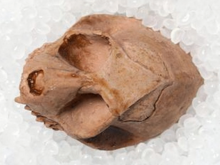Apidium
| Apidium | |
|---|---|

| |
| Scientific classification | |
| Domain: | Eukaryota |
| Kingdom: | Animalia |
| Phylum: | Chordata |
| Class: | Mammalia |
| Order: | Primates |
| Suborder: | Haplorhini |
| Infraorder: | Simiiformes |
| Family: | †Parapithecidae |
| Genus: | †Apidium Osborn, 1908 |
| Paleospecies | |
|
†Apidium phiomense | |
The genus Apidium (from Latin, a diminutive of the Egyptian bull god, Apis, as the first fossils were thought to be from a type of a cow) is that of at least three extinct primates living in the early Oligocene, from 30 to 28 million years ago. Apidium fossils are common in the Fayoum deposits of Egypt. Fossils of the earlier species, Apidium moustafai, are rare; fossils of the later species Apidium phiomense are fairly common.
Apidium and its fellow members of the Parapithecidae family are stem anthropoids that possess all the hallmarks of modern Anthropoidea.[1] Their ancestry is closely tied to the Eocene Asian group Eosimiidae.[2]
Age
[edit]Apidium fossils were originally thought to be between 35.4 and 33.3 million years old, based on initial analysis of the Jebel Qatrani Formation in which they were found. However, analysis by Erik Seiffert in 2006 concluded that the age of the Jebel Qatrani Formation should be revised. His assessment of more recent evidence indicates an age of between 30.2 and 29.5 million years ago, wholly within the Rupelian (early Oligocene) epoch.[3]
Behaviour
[edit]The Apidium species were well adapted to life in what once were the tropical forests of North Africa. They lived in trees and apparently moved on top of tree limbs by a combination of quadrupedalism and leaping, much as do living squirrel monkeys of the genus Saimiri.[4] These primates appear to have been frugivorous and diurnal, with keen eyesight.[5]
Male Apidium were bigger than the females, which, by comparing them with living primates, suggests that they probably lived in groups, where a small number of males would have had control over several females. The males had large canine teeth.[6]
The tooth chipping patterns in Apidium phiomense indicate a predominantly soft fruit diet.[7]
References
[edit]- ^ Fleagle J., Kay R.F. (1987). "The phyletic position of the Parapithecidae". Journal of Human Evolution. 16 (6): 483–532. doi:10.1016/0047-2484(87)90036-4.
- ^ Kay R.F., Williams B.A., Ross C.F., Takai M., Shigehara N., 2004. Anthropoid origins: a phylogenetic analysis. In: Ross C.F., Kay R.F. (Eds) Anthropoid Origins: New Visions. Kluwer/Plenum, New York, pp. 91-135
- ^ Seiffert Erik R. (Jan 2006). "Revised age estimates for the later Paleogene mammal faunas of Egypt and Oman". Proceedings of the National Academy of Sciences of the United States of America. 103 (13): 5000–5005. doi:10.1073/pnas.0600689103. PMC 1458784. PMID 16549773.
- ^ Kay R.F., Simons E.L. (1980). "The ecology of Oligocene African Anthropoidea". International Journal of Primatology. 1: 21–37. doi:10.1007/bf02692256. S2CID 23927951.
- ^ Bush E.C., Simons E.L., Allman J. (2004). "High-resolution computed tomography study of the cranium of a fossil anthropoid primate, Parapithecus grangeri: New insights into the evolutionary history of primate sensory systems". Anatomical Record Part A. 281A (1): 1083–1087. doi:10.1002/ar.a.20113. PMID 15470668.
{{cite journal}}: CS1 maint: multiple names: authors list (link) - ^ Fleagle J.G., Kay R.F., Simons E.L. (1980). "Sexual dimorphism in early anthropoids". Nature. 287 (5780): 328–330. doi:10.1038/287328a0. PMID 6999362. S2CID 438852.
{{cite journal}}: CS1 maint: multiple names: authors list (link) - ^ Towle, I.; Borths, M. R.; Loch, C. (2023). "Tooth chipping patterns and dental caries suggest a soft fruit diet in early anthropoids". American Journal of Biological Anthropology. doi:10.1002/ajpa.24884. PMID 38093580.




